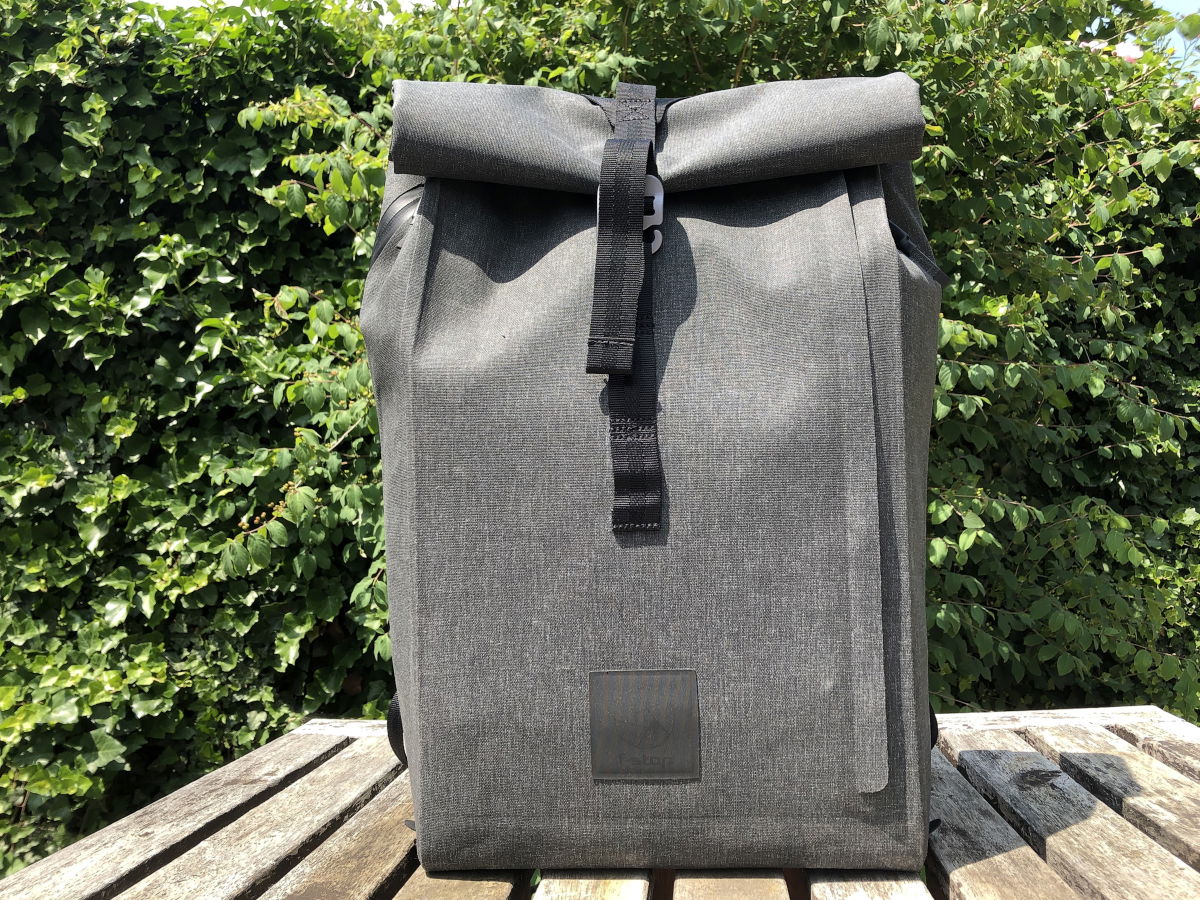The Fujifilm X-T200 lives in a tricky market segment. As smartphone cameras get better by the year, they challenge the very existence of cameras. This is especially true for cameras that belong in the entry-level bracket. What can a camera offer that your phone can’t?
Fujifilm aims to tackle this head-on by providing an easy-to-use camera that takes fantastic photos. This review specifically considers one area that Fujifilm clearly thinks the X-T200 stands out in—vlogging. Read on to see if they’ve succeeded in this aim.
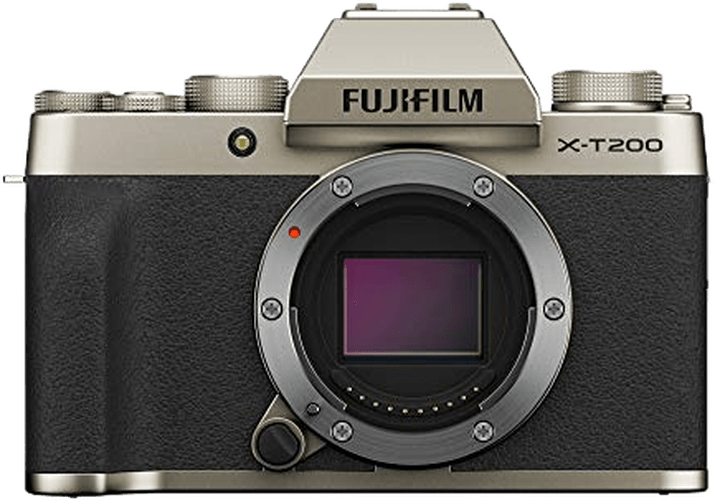

| Released |
Released
2020
|
| Sensor Format |
Sensor Format
|
| Lens Mount |
Lens Mount
Fujifilm X
|
| Megapixels |
Megapixels
24 MP |
| Autofocus Points |
Autofocus Points
425 |
| Maximum ISO (Native) |
Maximum ISO (Native)
12,800 |
| Frame Rate |
Frame Rate
8 fps |
| In-body Stabilization |
In-body Stabilization
|
| Video |
Video
|
Built around Fujifilm’s X-mount system, its heart is a 24 MP APS-C cropped sensor. This sensor does not feature Fuji’s well-known X-Trans color grid. Instead, it’s in line with all the other major manufacturers who use a Bayer filter.
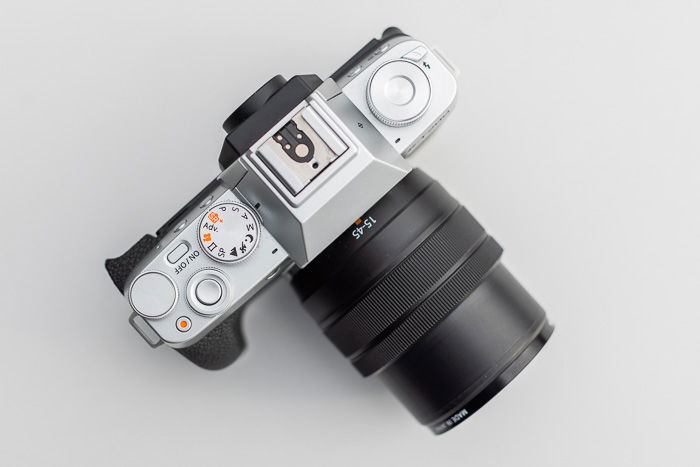
It also differs from most other Fuji cameras in terms of controls. Operating the X-T200 is similar to traditional digital cameras in that it doesn’t have specific dials for exposure controls. It also places emphasis on the touchscreen for basic operations.
Still, many aspects of the Fujifilm brand and approach are included in the X-T200. Its main design elements resemble those of the X-T1 and X-T10 series. The well-known JPG profiles (film simulations in Fuji language) also form a central part of photography with this camera.
This Fujifilm X-T200 review is a result of a two-week testing period and the camera was provided by Fujifilm UK. (Editor’s note: This article wasn’t sponsored by Fujifilm.)
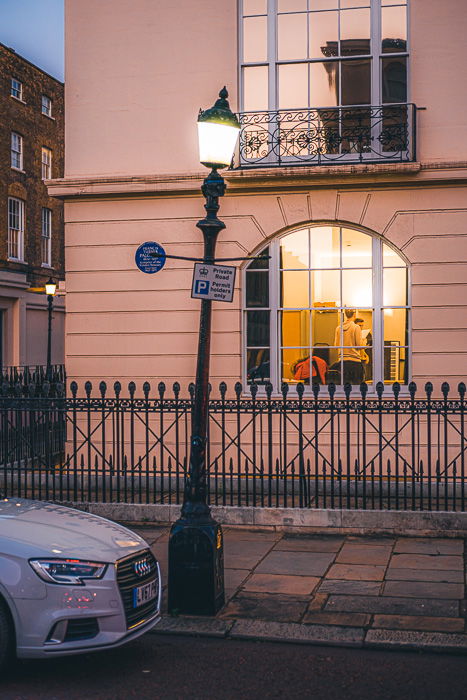
I received the Fujifilm X-T200 with the Vlogger Kit. This kit is targeted to videomakers primarily filming themselves. It includes:
I also tested the XC 35mm f/2 lens separately. And some of the images in this review are taken with it. Here’s my full review of the XC 35mm f/2.
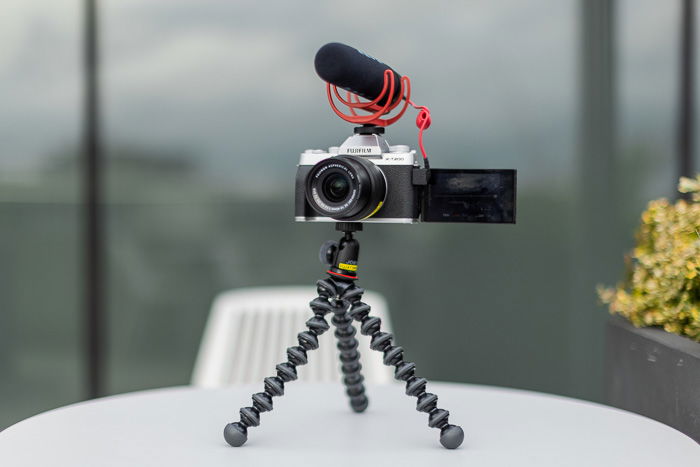
With the X-T200, Fujifilm targets photographers who are leaving smartphone photography and looking for a familiar experience with better results.
As entry-level products usually go, this is a fairly general-purpose camera. But it does perform really well compared to most alternatives, especially when it comes to video features.
The X-T200 appeals to those who particularly value Fujifilm’s brand and attitude. This includes shooting predominantly JPG, a slower photography process, and a stylish design.
Like many mirrorless cameras, it only has an electronic viewfinder. Those who prefer optical viewfinders should turn towards either DSLRs or Fujifilm’s rangefinder-inspired X100V and X-Pro series. But both of the latter are more expensive.
Now let’s dive in and see the strengths and weaknesses of the X-T200.
The X-T200 is built around Fujifilm’s X-mount, which was developed for APS-C mirrorless cameras. This lens mount has been around for around for over a decade, which has allowed it to develop into a versatile system.
Lens offerings for the X-mount include a wide range of zooms and primes, cheap and professional, general-purpose, and specific lenses made by Fujifilm and others.
Among those who manufacture native X-mount lenses are Zeiss, Viltrox, and recently Tokina. Manual-focus lenses are made by Lensbaby, 7Artisans, and others.
Its flange distance is 17.7mm. This is short, which allows for great adaptability with older lenses. High-quality adaptors for autofocus Canon EF, Nikon F, and many manual-focus rangefinders and SLR lenses are available.
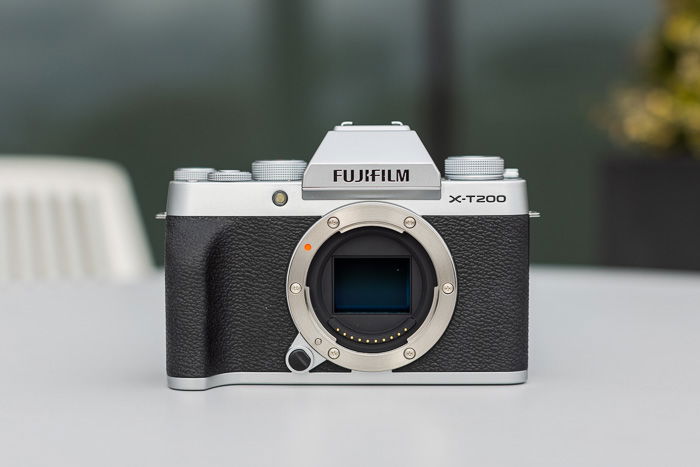
The Fujifilm X-T200 is in many aspects different from your ordinary modern Fuji camera. This rings true for its sensor. The 24 MP APS-C chip has a Bayer color filter. In each 2×2 pixel grid, there’s one red, one blue, and two green pixels. This is normal for most digital cameras. But Fujifilm usually outfits their cameras with X-Trans sensors.
One consequence of this is that colors from the X-T200 behave differently when shooting in RAW. They look different in JPEG compared to X-Trans cameras. Capture One has lost its usual advantage in processing the RAW files from this model compared to Lightroom.

Despite that, out-of-the-box image quality is excellent. It’s easier to make the X-T200 shoot polished, high-quality images than most other cameras shooting JPEGs.
However, I wasn’t so impressed by the RAW files coming out of the X-T200. In either Lightroom or Capture One, color-editing was noticeably harder than other Fujifilm files (although I’ve only tested X-Trans Fujis before). The RAW files are huge (over 40 MB each), as there is no option for lossless compression.

Low-light performance is good, but not up to the latest standards in APS-C sensors. But this is reasonable in an entry-level camera. Dynamic range is excellent at the base ISO of 200, but quickly diminishes once you reach ISO 1600. And colors start to really fall apart above 3200.
Keep in mind that Fujifilm uses a different ISO standard than other manufacturers. ISO 200 on Fujifilm is roughly equivalent to ISO 100-125 on other brands.
The X-T200’s autofocus system is up to standard, as long as the standard is modern entry-level cameras.
It’s a hybrid system that employs a sensor-based phase-detection for quick adjustments and contrast detection for accuracy. It works surprisingly well in low light. Even in darkness, the camera finds something to autofocus on most of the time.
It tracks subjects reasonably well, but I had to do some tweaking to make this work smoothly. In auto mode, it’s not quite as reliable. Face detection is quick but mixes up subjects with faces often, especially over complex background textures. If you enable it, you can’t override it. So, if it ends up unfocused, you either need to try again or turn it off.
In the end, I often found myself using single-point AF, as that was the most consistent.

You can select your focus using either the joystick (focus lever) or the touchscreen. But I had to turn off the latter option. Even with my eye up to the viewfinder (and the screen not displaying anything), you can move focus points using the touchscreen. But this is inconvenient. I’m left-eye dominant, so my nose was constantly bumping the focus point on the screen to somewhere unexpected. But when you only use the touchscreen, touch-to-focus works well.
The Fujifilm X-T200 is capable of shooting 8 fps with continuous autofocus. Neither of my lenses has an autofocus speed capable of catching up to this camera’s burst speed. Also, the buffer fills up quickly because of the huge RAW files and slow SD card slot. But with stationary subjects, this is a neat feature. Not long ago, 8 fps was a headline selling point.
Overall though, I feel that here we get what we expect. All modern Fujifilm cameras perform better than the X-T200. But to be fair, this performance would have warranted a much higher rating just a few years ago. It’s still a practical camera.
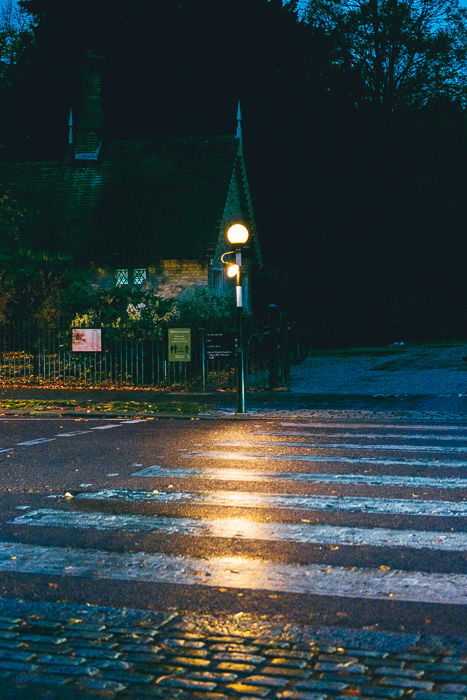
Fujifilm markets the X-T200 to casual video shooters and vloggers. It does provide satisfactory video quality, although I’ve found it impractical for actual vlogging.
The camera shoots 30p 4K video in 8-bit internally, with the same options available for external recording through the micro-HDMI port. There is a 15-minute limit on 4K recording and a 30-minute limit on 1080p.
The 4K footage looks really nice. It’s sharp, the colors are amazing, and although it’s 8-bit, it can be decently graded with the Eterna profile. But the 1080p footage is quite disappointing—it’s relatively soft, particularly at 120p.
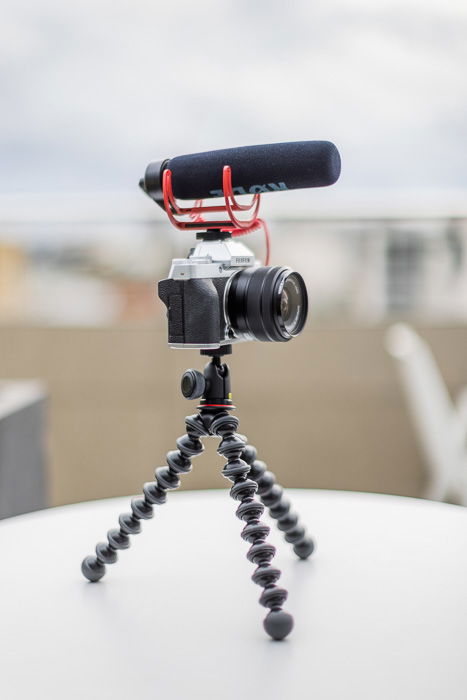
The camera has a microphone jack. With the included USB-C to jack adaptor, you can also connect headphones, which stands out among rivals.
The face detection autofocus displays the same issues as in photography mode. It’s prone to picking up trees and urban elements instead of human faces. I found the full-area tracking autofocus to be more effective.
But for casual video shooting in 4K, the Fujifilm X-T200 is really good.
It’s not so practical for vlogging, though. There is no stabilization built into the camera. Unless you use a stabilized lens or a gimbal, it will be shaky. The microphone and the headphone jacks protrude in front of the flipped-out screen, blocking some of the view.
Auto-exposure for video has the same issue as Fujis have had for generations—it only adjusts exposure in 1/3rd stops. This results in exposure transitions that are rough and bumpy. And if you have a plate or handle attached to the bottom of the X-T200, you can’t swap out the card or battery.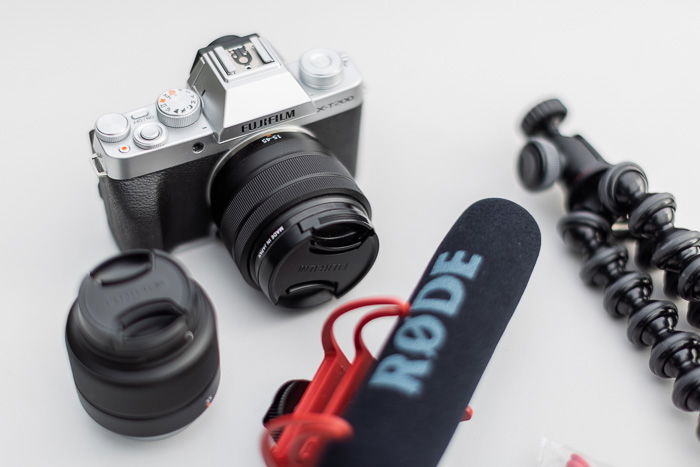
The Fujifilm X-T200 is a small, light, and attractive camera. It does indeed have plenty of positives going for it. However, one of the main weaknesses of X-T200 is the design and ergonomics.
The X-T200 measures 121 x 83.7 x 55.1mm and weighs about 370 grams.
The body is primarily made of plastic with some aluminum reinforcements along the bottom and top sections. Most of it is covered in easy-to-grip black plastic. It’s well put together, but the construction feels quite cheap (which it is, to be fair). There are also design flaws, some of which Fujifilm have been making for years.
Most notably, the tripod mount and the combined battery/SD card door are too close together. If there is a tripod plate attached, you can’t open the door. This is especially troubling for a camera aimed at videographers, who tend to keep things attached to the mount and swap batteries and cards frequently.
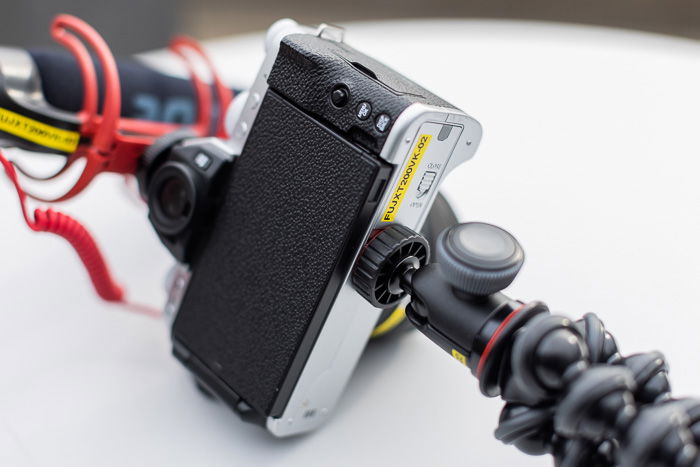
In terms of battery life, the Fujifilm X-T200 is an average performer. A fully charged battery gives me about 250 shots.
It accommodates UHS-I SD cards in its single card slot. These are not fast enough to sustainably write 8 RAW files every second, as I mentioned earlier.
There is a pop-up flash on top of the camera. It can be activated by a physical lever next to the simulation dial.
In terms of controls, the camera has two customizable function buttons. There is a mode dial, a freely customizable dial, and a dial for switching film simulations. This, annoyingly, can’t be customized. On the back, there is a joystick which Fujifilm calls a focus lever. This is the main controller of the camera. You can use it to switch focus points and navigate around the menus.
A large 3.5-inch flip-out touchscreen occupies most of the space on the back. This recreates some of the smartphone experience that Fujifilm has promised.
There is a new quick menu interface specifically developed for this camera that relies heavily on touchscreen operation. Still, I felt that the lack of intuitiveness and simplicity holds the X-T200 back slightly. The main menu is not straightforward. And the two different quick menus are redundant and confusing.
Unfortunately, the EVF is one of the most disappointing features of this camera. Its size (0.62x), refresh rate, and resolution are quite low. But it’s possible that the target users will not use the viewfinder as much as the touchscreen.
Neither the X-T200 nor the two recommended kit lenses are weather sealed.

The Canon M50 Mk II is a mirrorless camera similar in size and price. It also has a 24 MP APS-C sensor. Its video features and image quality don’t hold a candle to the Fujifilm X-T200. But the autofocus performance and ergonomics are considerably better. It is also more intuitive to use despite the lesser focus on touchscreen operation. Lens options for the Canon EF-M mount are not so diverse. However, the quality of the main kit lens is better than Fujifilm’s.
The Olympus E-M10 Mk IV is an entry-level mirrorless camera built around a 20 MP Micro Four Thirds sensor. After its release, it was the best on the market with 4.5 stops of in-body stabilization. Plus, many MFT lenses are stabilized. It’s on par with Canon for ease of use. This includes great touchscreen integration and clearly marked but customizable buttons. Its electronic viewfinder is also the best in the category. The Mk IV has improved upon its predecessor, the E-M10 Mk III, but the difference isn’t huge.
For vlogging, there is the Sony ZV-1. It has a 1-inch 20 MP backside-illuminated sensor. This camera doesn’t feature interchangeable lenses. But it does have a high-quality 24-70mm-equivalent lens. Video shooters benefit from excellent built-in stabilization, better audio features, a 960 fps video mode, and a portable size. This camera is not only marketed towards vloggers, but clearly designed for them. I recommend you opt for this instead if you’re making professional videos.
The Canon SL3 (or 250D) is an entry-level DSLR. It appears here because of its small size, competitive features, and arguably the best ergonomics due to its large grip. It has a 24 MP APS-C sensor with similar image quality to the M50. It’s built around the Canon EF mount, so lens choices are close to infinite.
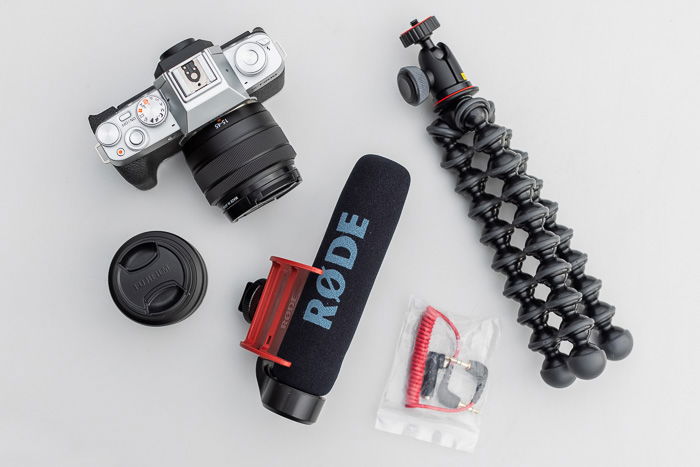
The Fujifilm X-T200 is a competent entry-level camera. It produces excellent image quality for its class. And it has a cool design and very competitive video features. Looking at the specifications list, this wass one of the most powerful cameras on the entry-level market when it was first released.
| Measurement |
Measurement
Score
|
| Main Features |
Main Features
|
| Extra Features |
Extra Features
|
| Construction and Durability |
Construction and Durability
|
| Handling and Ergonomics |
Handling and Ergonomics
|
| Value for Money |
Value for Money
|
| Total Score |
Total Score
|

